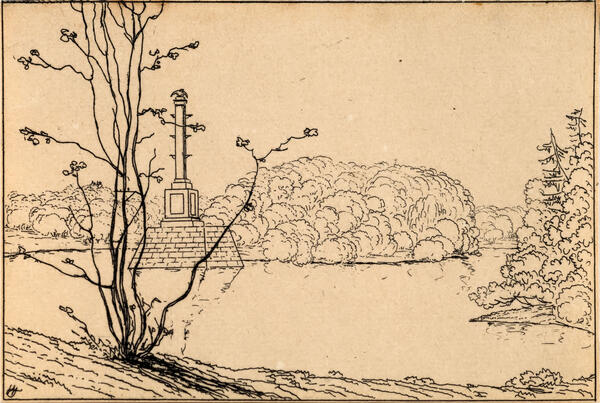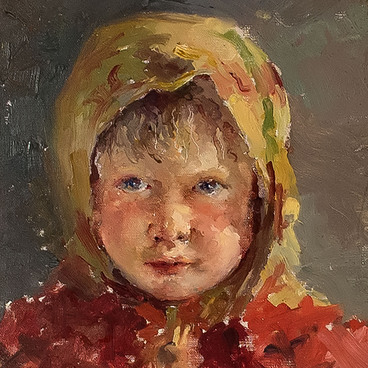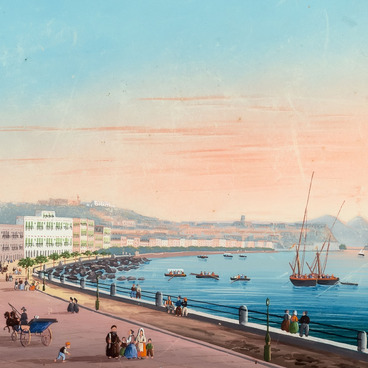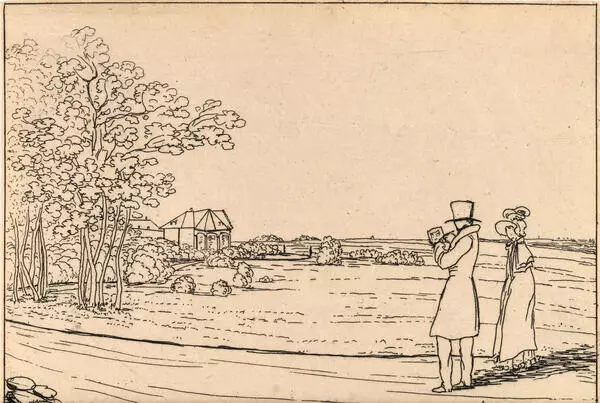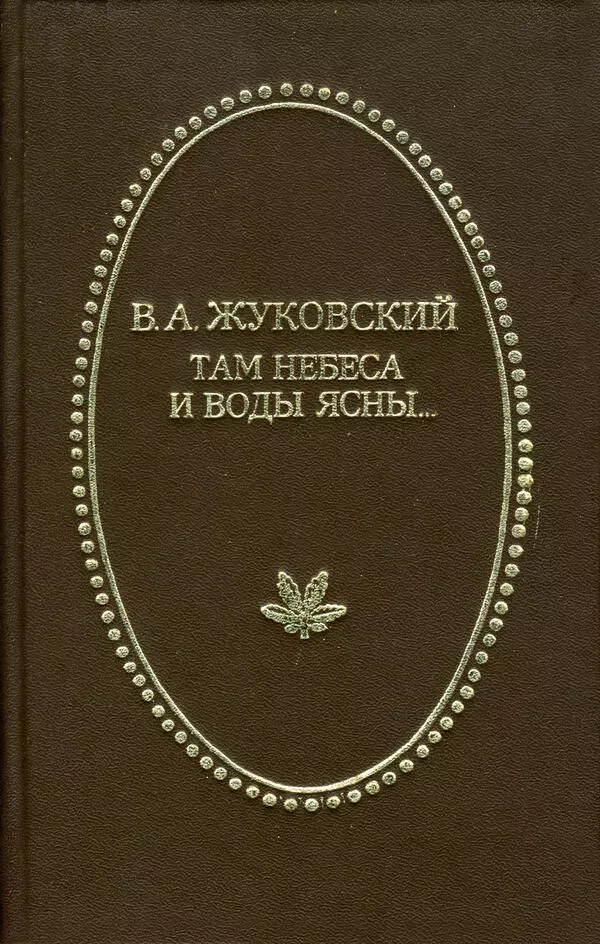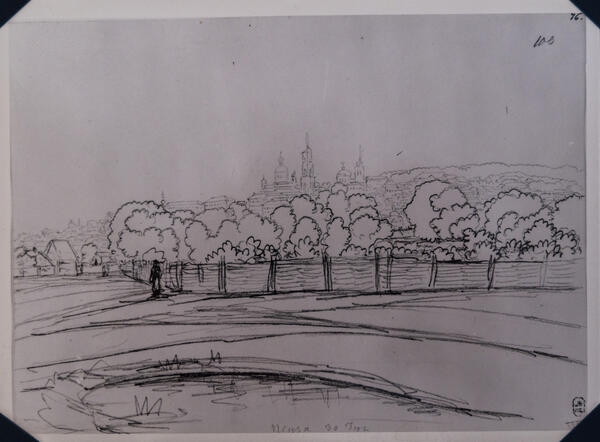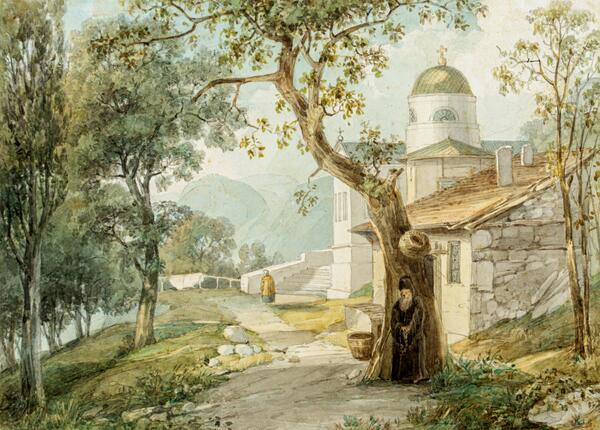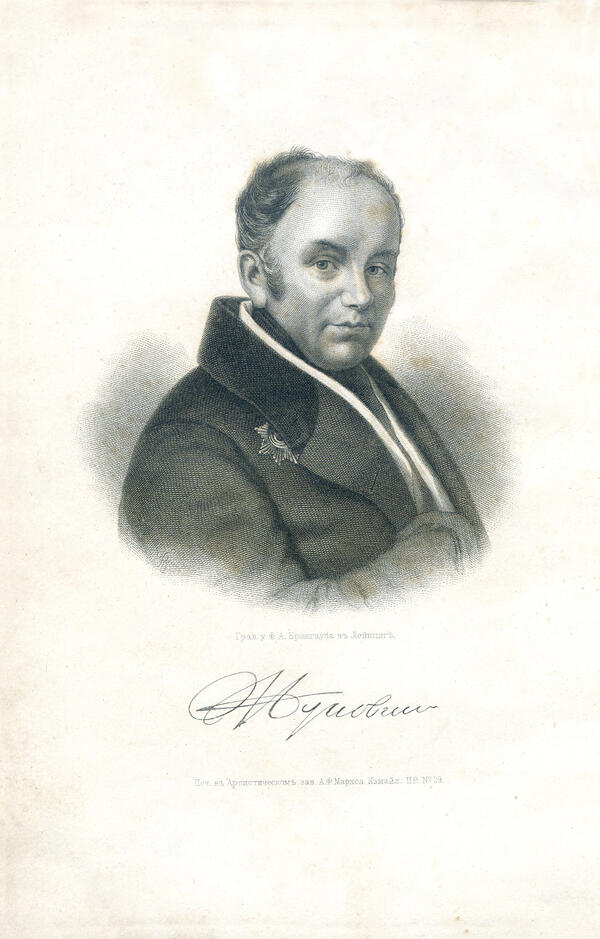The passion for drawing had an important place in the creative life of the poet Vasily Zhukovskiy, communication with whom played an important role in the coming-of-age of Evgeniy Boratynskiy. Zhukovskiy said that for him paintings and poetry are sisters. He studied at the Noble Boarding School at the Moscow University (from 1797 till 1801). It was at this time that he began writing poetry as well as drawing and painting.
To date, Zhukovskiy’s artistic heritage consists of approximately 2,000 works. They are mostly travel albums with many drawings in pencil and ink, but there are also works of printed and book graphics, works done in watercolors and gouache. As a rule, the poet painted panoramic landscapes with city views, mountainous and rural landscapes, various architectural monuments.
One of the central places in Zhukovskiy’s artistic heritage are the views of the suburbs of Petersburg. His albums and individual sheets with views of Peterhof, Tsarskoye Selo, Gatchina and Pavlovsk were published many times.
Zhukovskiy also created numerous calligraphic etching and engravings, often based on his own drawings. In 1816, he became interested in the technique of calligraphic etching, when he met Karl Senff, a professor at the University of Derpt.
Though Zhukovskiy was not attracted to majestic palatial buildings and large architectural ensembles. His favourite theme was panoramic landscapes, intricate patterns from the contours of trees and constructions in which the artist’s remarkable vision can be noticed. Contemporaries were surprised by “the precision of his eye, the ability to choose the points from which he depicts objects, and the ability to capture things characteristically, in the swiftest outlines”.
The drawings and calligraphic etchings of Zhukovskiy are notable in that they make you look back at an interesting page in the Russian art of the first half of the 19th century - amateur creativity, which for a long time remained poorly studied. But, of course, it was strongly related to the overall development of artistic culture.
The eight of Zhukovskiy’s etchings, made in the early 1820s, are dedicated to views of Tsarskoye Selo. The etching from the museum’s collection depicts a part of Yekaterininsky Park in Tsarskoye Selo – the Chesme Column. In the foreground there is a lonely bush on the bank, through the branches of which there is a view of the monument celebrating naval victories and the power of Russia on the sea - the Great Rostral Column, also called Chesme or Orlovskaya in memory of the battle at Chesme Bay in 1770. The monument is made of marble from Olonetsk and was constructed by architect Antonio Rinaldi in 1776.
To date, Zhukovskiy’s artistic heritage consists of approximately 2,000 works. They are mostly travel albums with many drawings in pencil and ink, but there are also works of printed and book graphics, works done in watercolors and gouache. As a rule, the poet painted panoramic landscapes with city views, mountainous and rural landscapes, various architectural monuments.
One of the central places in Zhukovskiy’s artistic heritage are the views of the suburbs of Petersburg. His albums and individual sheets with views of Peterhof, Tsarskoye Selo, Gatchina and Pavlovsk were published many times.
Zhukovskiy also created numerous calligraphic etching and engravings, often based on his own drawings. In 1816, he became interested in the technique of calligraphic etching, when he met Karl Senff, a professor at the University of Derpt.
Though Zhukovskiy was not attracted to majestic palatial buildings and large architectural ensembles. His favourite theme was panoramic landscapes, intricate patterns from the contours of trees and constructions in which the artist’s remarkable vision can be noticed. Contemporaries were surprised by “the precision of his eye, the ability to choose the points from which he depicts objects, and the ability to capture things characteristically, in the swiftest outlines”.
The drawings and calligraphic etchings of Zhukovskiy are notable in that they make you look back at an interesting page in the Russian art of the first half of the 19th century - amateur creativity, which for a long time remained poorly studied. But, of course, it was strongly related to the overall development of artistic culture.
The eight of Zhukovskiy’s etchings, made in the early 1820s, are dedicated to views of Tsarskoye Selo. The etching from the museum’s collection depicts a part of Yekaterininsky Park in Tsarskoye Selo – the Chesme Column. In the foreground there is a lonely bush on the bank, through the branches of which there is a view of the monument celebrating naval victories and the power of Russia on the sea - the Great Rostral Column, also called Chesme or Orlovskaya in memory of the battle at Chesme Bay in 1770. The monument is made of marble from Olonetsk and was constructed by architect Antonio Rinaldi in 1776.

